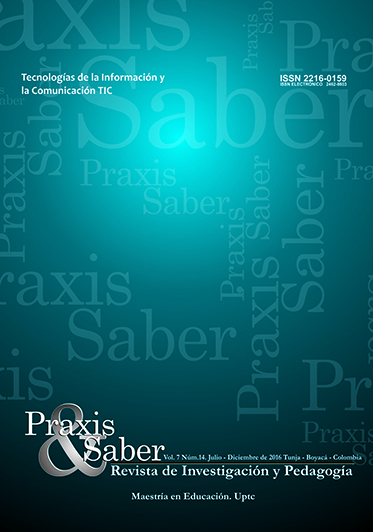Emotions Viewer in an Experience, Photographic, Pictorial and Film

Abstract
In this article the results of the comparative analysis of three studies are discussed: The Science of Art: A Neurological Theory of Aesthetic Experience (1999) Neural Correlates of Beauty (2004) and Neurocinematics: the Neuroscience of Film (2008). Each of the aforementioned research examines the neuronal activity of a group participants observed photographs, paintings or films. It was considered that the exposed experiences allow understanding the scope and purpose of neurocinema. The method of investigation was to review and analytical approach. Tables were designed to systematize the revision of the texts and descriptive tables based on abstracting RAE were developed. It is concluded that two of the studies had in common that participants showed neuronal activity in the area of the limbic system, the brain region that processes emotions.Keywords
art, brain, emotions, experience, limbic system
Author Biography
Francisco de Paula Contreras Albornoz
Candidato a Master en Escrituras Creativas
Luis Fernando Gasca Bazurto
Candidato a Master en Literatura y Cultura
References
- ARIELY, D., & BERNS, G. S. (2010). Neuromarketing: the hope and hype of neuroimaging in business. Nature Reviews. Neuroscience, 11(4), 284–292. Recuperado de: http://www.ncbi.nlm.nih.gov/pmc/articles/PMC2875927/http://doi.org/10.1038/nrn2795
- https://doi.org/10.1038/nrn2795
- ARISTÓTELES. (1946). Arte poética. Arte retórica. México: Editorial Porrúa.
- AXTLE, M. A. (2014). Neuromercadotecnia. Marketing científico. Istmo. Liderazgo con valores, 316. Recuperado el 20 de julio del 2014, en: http://web.uas.mx/negocios/gestione/Desp_Arts.asp?titulo=523
- COHEN, D. S. (2010, 04). James Cameron supercharges 3-D. Variety. Recuperado de http://variety.com/2008/digital/features/jamescameron-supercharges-3-d-1117983864/
- CHRONISTER, R. B., & HARDY, S. G. (2003). "Sistema Límbico". En Haines, D. E. (Editor), Principios de neurociencia. 2 ed. (pp. 493 – 505). Madrid - Barcelona: Elsevier Science S.A.
- DAMASIO, A. R. (2005). En busca de Spinoza: Neurobiología de la emoción y los sentimientos. Barcelona: Crítica.
- DAMASIO, A. R. (1994). El error de Descartes: La emoción, la razón y el cerebro humano. Santiago de Chile: Andrés Bello.
- DUQUE, M. E. Á. (2013). La neurociencia en las ciencias socio-humanas: una mirada transdiciplinar. Ciencias Sociales y Educación, 2(3). Recuperado de: http://revistas.udem.edu.co/index.php/Ciencias_Sociales/article/download/808/748
- GARDNER, A. (2009). Neurocinematics: Your brain on film. Recuperado de: http://newenglandfilm.com/magazine/2009/06/neurocinematicsyour-brain-on-film
- HASSON, U., LANDESMAN, O., KNAPPMEYER, B., VALLINES, I., RUBIN, N., & HEEGER, D. J. (2008). Neurocinematics: The neuroscience of film. Projections, 2(1), 1-26. Recuperado de: http://ohadlandesman.com/pdf/Neurocinematics-Projections2008.pdf
- https://doi.org/10.3167/proj.2008.020102
- HAINES, D. E., MAY, P. J., & MIHAILOFF, G. A. (2003). "Mesencéfalo". En Haines, D. E. (Editor), Principios de neurociencia. 2 ed. (pp. 187 – 199). Madrid - Barcelona: Elsevier Science S.A.
- HAINES, D. E., & MIHAILOFF, G. A. (2003) "Diencéfalo". En Haines, D. E. (Editor), Principios de neurociencia. 2 ed. (pp. 219 – 235). Madrid - Barcelona: Elsevier Science S.A. Impreso.
- HAMMOU, K. A., GALIB, M. H., & MELLOUL, J. (2013). "The contributions of neuromarketing in marketing research". Journal of Management Research, 5(4), 20. Recuperado de: http://macrothink.org/journal/index.php/jmr/article/download/4023/3403
- https://doi.org/10.5296/jmr.v5i4.4023
- HERNÁNDEZ, S. R., FERNÁNDEZ, C. C., & BAPTISTA, L. P. (1997). Metodología de la investigación. Bogotá: McGraw-Hill. Recuperado de: http://www.dgsc.go.cr/dgsc/documentos/cecades/metodologia-de-lainvestigacion.pdf
- HIRSTEIN, W. & RAMACHANDRAN, V. S., (1999). The science of art: A neurological theory of aesthetic experience. Journal of consciousness Studies, 6(6-7), 15-51. Recuperado de: http://www.imprint.co.uk/rama/art.pdf
- JOHNSON, K. & BECKER, A. (1995-1999) The whole brain atlas. Harvard University. Recuperado de: http://www.med.harvard.edu/AANLIB/home.html
- KAHNEMAN, D. (2011). Thinking, fast and slow. Macmillan. Recuperado de: https://vk.com/doc23267904_175119602
- KAWABATA, H., & ZEKI, S. (2004). Neural correlates of beauty. Journal of neurophysiology, 91(4), 1699-1705. Recuperado de: http://jn.physiology.org/content/91/4/1699.short
- https://doi.org/10.1152/jn.00696.2003
- KERNAN, L. (2009). Coming attractions: Reading American movie trailers. University of Texas Impreso.
- KOSSLYN, S., M., & SMITH, E. D. (2008). Procesos cognitivos: modelos y bases neurales (1ª ed., pp. 1-664). Madrid: Pearson Educación, S.A. Recuperado de: http://macrothink.org/journal/index.php/jmr/article/download/4023/3403
- LINDSTRÖM, M., & ARIAS, H. A. (2009). Compradicción: Verdades y mentiras de por qué las personas compran. Bogotá: Grupo Editorial Norma.
- LYNCH, J. C. (2003) "Corteza cerebral" En Haines, D. E. (Editor), Principios de neurociencia. 2 ed. (pp. 505 – 518). Madrid - Barcelona: ELSEVIER SCIENCE S.A. Impreso.
- LITTLEFIELD, M. M., FITZGERALD, D., KNUDSEN, K., TONKS, J., & DIETZ, M. J. (2014). Contextualizing neuro-collaborations: reflections on a transdisciplinary fMRI lie detection experiment. Frontiers in Human Neuroscience, 8, 149. Recuperado de: http://www.ncbi.nlm.nih.gov/pmc/articles/PMC3978358/
- https://doi.org/10.3389/fnhum.2014.00149
- MEJÍA, D. I. L., DE YAHYA, A. V., MÉNDEZ, D., M., & MENDOZA, F., V. (2009). El sistema límbico y las emociones: empatía en humanos y primates. En la Variedad está el Enriquecimiento. In Diversity we find Enhancement, 60. Recuperado de: http://www.iberoamericana.edu.mx/web/files/publicaciones/ripsic/ripsic17-2.pdf#page=60
- MODO, M., & KINCHIN, I. (2011). A Conceptual Framework for Interdisciplinary Curriculum Design: A Case Study in Neuroscience. Journal of Undergraduate Neuroscience Education, 10(1), A71–A79. Recuperado de: http://www.ncbi.nlm.nih.gov/pmc/articles/PMC3598188/
- NASER, M., A. (2015). Neurocinema: A brief overview. Iranian Journal of Neurology, 14(3), 180–184. Recuperado de: http://www.ncbi.nlm.nih.gov/pmc/articles/PMC4662695/
- RANDALL, K. (2011, 02, 25). Rise of neurocinema: How hollywood studios harness your brainwaves to win Oscars. Fast Company. Los Ángeles: Fast Company Inc. Recuperado de: http://www.fastcompany.com/1731055/rise-neurocinema-how-hollywood-studios-harness-your-brainwaveswin-oscars
- SASTRE, M. B. F. (2016). "Teatro y neurociencias: el proceso creativo del actor desde la neurofisiología de la acción". Acotaciones, (35). Recuperado de: http://www.resad.com/Acotaciones/index.php/ACT/article/viewFile/7/101
- SILER, T. (2015). Neuroart: picturing the neuroscience of intentional actions in art and science. Frontiers in Human Neuroscience, 9, 410. Recuperado de: http://www.ncbi.nlm.nih.gov/pmc/articles/PMC4511838/
- https://doi.org/10.3389/fnhum.2015.00410
- SHIV, B., BECHARA, A., LEVIN, I., ALBA, J. W., BETTMAN, J. R. …MCGRAW, A. P. (2005). Decision neuroscience. Marketing Letters, 16(3- 4), 375-386. Recuperado de: https://faculty.fuqua.duke.edu/~jrb12/bio/Jim/shivetalchoiceconf.pdf
- https://doi.org/10.1007/s11002-005-5899-8
- SPURLOCK, M., CHILNICK, J., HUREWITZ, A., CALDER, K., WU, J., MARRACINO, D., VOGT, T. M., ... Sony Pictures Home Entertainment (Firm). (2011). The greatest movie ever sold. Culver City, Calif: Sony Pictures Home Entertainment. Recuperado de: https://vimeo.com/110443507
- UNIVERSIDAD PEDAGÓGICA NACIONAL. (2012, 10). Elaboración de resúmenes analíticos en educación - RAE. Sistema integrado de gestión. Universidad Pedagógica Nacional. Obtenido 03, 2015, de http://mpp.pedagogica.edu.co/download.php?file=elaboracion_de_resumenes_analiticos_en_educacion_rae_.pdf
Downloads
Download data is not yet available.